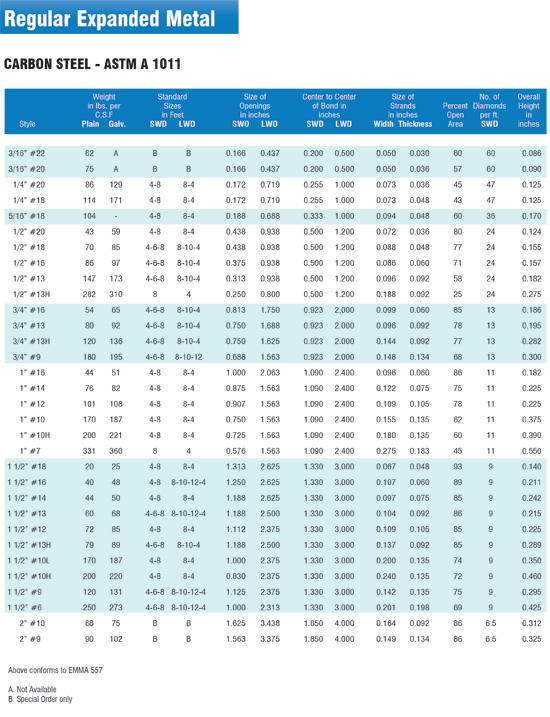Expanded Metal Mesh in Architecture
Exciting new uses for a proven material
![]() Continuing Education
Continuing Education
Use the following learning objectives to focus your study while reading this month’s Continuing Education article.
Learning Objectives - After reading this article, you will be able to:
- Identify and recognize the characteristics of expanded metal mesh for use in architectural applications.
- Investigate the design potential and innovative opportunities to use expanded metal mesh in different design applications.
- Assess the functional contributions of expanded metal mesh as it may contribute to green and sustainable design.
- Specify expanded metal mesh in a variety of buildings and formulate appropriate selections related to specific applications.
Designers routinely use interior and exterior surface materials to provide a visual and sensory experience of a building. Smooth, pristine surfaces create an obviously different design experience than a textured one. Similarly, surfaces that can bend or flow to provide a more threedimensional experience create buildings with a very different design sense than flat rectilinear structures. Materials that allow air and light to penetrate them provide other design opportunities compared to opaque materials. For each of these design conditions, there is one material that can actually address them all and has seen a surging popularity in both interior and exterior applications. This material is known generically as expanded metal mesh and is a well-known, time-proven material in many industrial and heavy-usage building conditions. It has also recently been discovered as a very f lexible, affordable, and customizable material that can create a wide variety of appearances and functions that create exciting design possibilities for buildings of all types.
Characteristics of Expanded Metal Mesh
As the name implies, expanded metal mesh is fabricated from various types and thicknesses of metal. The “expanded” part means that it is different, however, from punched or perforated metal. If sheet or coil metal has a pattern of holes cut or punched into it, creating loose pieces of scrap that fall from those holes, then that defines punched or perforated metal. By contrast expanded metal mesh is fabricated from sheet or coil metal that is slit and stretched into a nonraveling unit of uniform-size diamond-shaped openings. This process of slitting and stretching means not only that waste or scrap is eliminated, it means that in certain cases a 4-foot by 10-foot piece of metal is actually stretched into a mesh that measures on the order of 12 feet by 10 feet when processed. As such, the final product is inherently very efficient in terms of material usage which translates into great cost-effectiveness.
Manufacturing
The manufacturing process for expanded metal mesh was first patented in Hartlepool, UK, in the 1880s, and despite the amount of time that has elapsed since then, it’s current manufacture remains true to the original idea.
The process is simple but incredibly effective. Expanded metal is formed in an expanding press. Either stock size or custom size metal sheet or coil stock is fed into the expanding machine. Each machine is fitted with a unique “knife” dedicated to a particular pattern. The machines are then programmed or manually controlled to ensure that the metal is slit, sheared, and then stretched in a single process creating the apertures and therefore expanding the metal. The base metal is simultaneously slit and cold-formed, which expands the slits into diamond-shaped openings of uniform size and regularity. The diamonds typically range from about 1/8 inch to 3 inches (3 to 76 mm) wide and ¼ inch to 8 inches (6 to 200 mm) long. Custom knives can be manufactured to create different design patterns of openings. The resulting mesh is then either cut into sheets or wound onto coils ready for shipping or further processing.
The specific metal used to fabricate the expanded metal mesh can come in a range of metal types and thicknesses. Common choices include carbon steel, aluminum, and stainless steel. However, it is also possible to find manufacturers that produce expanded mesh from specialty metals such as brass, weathering steel, copper, titanium, nickel based alloys, and even some types of plastic. The combination of metal type and thickness helps determine not only the final appearance of the expanded metal mesh, it also plays directly into the overall strength, rigidity, and durability of the final product when installed in specific settings.
The manufacturing process and material selections allow for great versatility in the types of expanded metal mesh that are possible and available. The opening sizes or apertures can be made in a full range of dimensions from very small micro mesh openings to very large openings. A variety of depths are also possible to create a rather flat mesh surface or a very threedimensional surface with considerable depth between the front and rear of the mesh. These variations in openings and depth facilitate the free flow of air, fluid, or light where required at the degree or intensity desired or required.
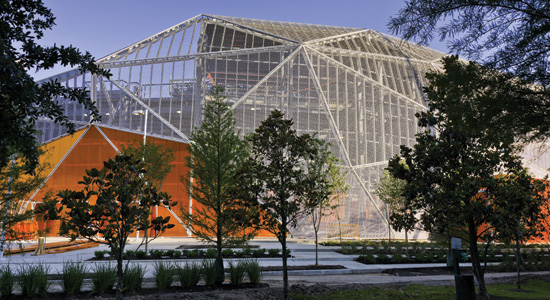 |
Expanded metal mesh provides a unifying architectural enclosure that allows both light and air to penetrate as determined by design. Photo by G. Lyon Photography, Inc., courtesy of AMICO |
Industry Standards
Since expanded metal mesh has been available for quite some time, the industry has matured and standards have been developed regarding this product. As would be expected, it is the National Association of Architectural Metal Manufacturers (NAAMM) that has advanced and promoted those industry standards. In fact, they have gone so far to establish a separate division of NAAMM known as the Expanded Metal Manufacturers Association (EMMA) Division.
NAAMM standard EMMA 557-12 was published in 2012 under the title of “Standards for Expanded Metal.” It introduces the material, offers some product selection considerations, defines industry terminology, describes the manufacturing process, reviews manufacturing tolerances, and offers some application information. Among the most basic information, the following terms are important to understand from this standard.
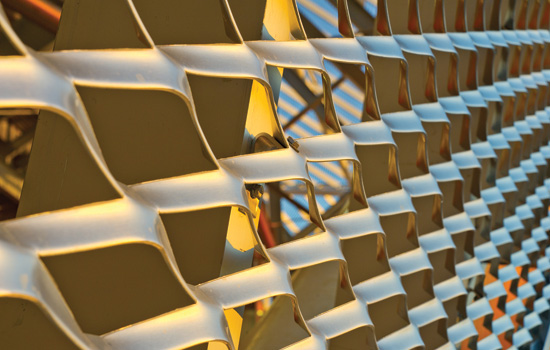 |
Expanded metal mesh is created by slitting and stretching flat sheet metal to create diamond shaped openings with virtually no waste. Photo courtesy of AMICO |
Expanded Metal — A rigid piece of metal which has been slit and drawn into an open mesh pattern in a single operation. Conventional mesh is formed in a diamond pattern.
Diamonds — Open area of metal after expanding. Most expanded metal patterns are diamond shaped but may also be hexagonal, louvered, asymmetric, etc.
Design Designations —
SWD. Nominal dimension, Short Way of Diamond.
LWD. Nominal dimension, Long Way of Diamond.
Design size. Actual dimension SWD and LWD. Measured from a point to a corresponding point on the adjacent diamond.
SWO. Short Way of Opening.
LWO. Long Way of Opening.
Strands. The sides of the expanded metal design.
Strand thickness. Thickness of the base metal.
Strand width. Amount of metal fed under dies to produce one strand.
Strand thickness and width. Can be varied to create different openings. The width of the strand should equal or exceed the thickness of the base metal.
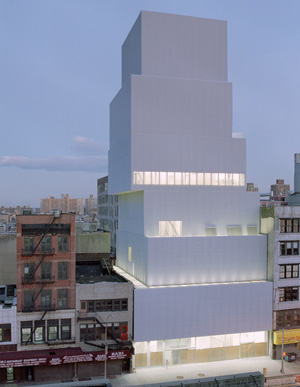 |
The outer skin of the New Museum of Contemporary Art in New York City is clad in expanded metal. The bright aluminum surface catches the light reflecting the changing moods every day throughout the year. Photo by SANAA Architects, courtesy of AMICO |
Bond — Intersection of two strands.
Fine Mesh — A precise, miniature version of standard expanded metal with SWD openings measuring under 0.140 inch (3.55 mm). Material as thin as 0.002 inch (0.05 mm) can be expanded. Available in a variety of metals and alloys including gold, silver, and platinum, they are often used for retaining filtration material, custom decoration for small appliances, and as battery electrodes.
Edge Configuration — The condition of the edge of an expanded metal sheet. This designation usually refers to “open” (random) or “closed” (bond) diamond edges produced from shearing.
Expanded metal mesh is often referred to by different styles. Standard (S) or Regular (R) expanded metal is mesh as it comes from the press. The strands and bonds are set at a uniform angle to the plane of the sheet.
Standard expanded metal offers high rigidity in a variety of sizes and weights. The angles of the diamond strands allow maximum air circulation and distribute stress on the metal to supporting frames. By contrast, Flattened (F) expanded metal is mesh that has been cold-rolled after expansion, to provide a smooth, flat, and level sheet. The flattening process reduces the original thickness of the base metal. Flattened expanded metal is used in a variety of specialty applications, such as lawn furniture, book and storage shelves, lamps and lamp shades, fireplace screens, many types of grilles, occasional tables, folding screens, room dividers, and air filtration filters.
Architectural or decorative meshes are also identified as an industry category of expanded metal mesh and are used to provide privacy, reduce air conditioning requirements, and to control light and air while allowing visibility. Sun screens, room dividers, and building facades are only a few of the design possibilities.
Decorative meshes are available in many styles and weights, ranging from delicate thin-strand designs to heavier patterns which approximate the appearance of considerably more expensive cast and wrought iron products.
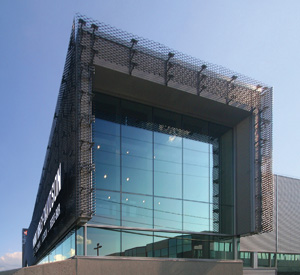 |
Expanded metal mesh used as building cladding such as on this Harley Davidson facility in Quebec creates a striking and functional façade treatment. Photo courtesy of AMICO |
Diamond patterned expanded metal mesh is typically referred to by size and style using standard recommended nomenclature further defined within the NAAMM standard as follows:
- Industrial Diamond Patterns: Carbon Steel — The first numerals express the Style or Design: (Example: 3/4” # 9). The letter S or F following the Style or Design designates “Standard” or “Flattened” Expanded Metal. For stainless steel, the designation will be the same except that the stainless steel type must be specified (Example: 304, 316, etc.). Similarly, for aluminum the nomenclature will follow that of carbon steel except the exact decimal equivalent of the aluminum is used to specify thickness.
- Small Diamond Designs — up to 3/16 inch. The industry nomenclature is essentially the same as Industrial Diamond Patterns described above except that the strand width is designated.
- Decorative or architectural mesh can vary widely since it is usually designed and detailed by a manufacturer. Consult manufacturers directly for available patterns.
- Fine Mesh is also usually designed and specified by manufacturer. Similarly, consult the manufacturer for available patterns and sizes. When using the NAAMM Standard to refer to expanded metal mesh, a complete designation is appropriate to avoid possible error. SWD dimension is always given before LWD dimension:
- Example: ½” #20 S (Standard), Carbon Steel 4” SWD x 8” LWD
Design Applications
The key design trait of expanded metal mesh is its versatility. The technical and manufacturing aspects of the product allow for custom fabrications but without a custom price tag. Hence it is enjoying a variety of uses in buildings.
Uses of expanded metal products fall into five principal areas: enclosure, protection, support, decoration and filtration. The light weight and strength of expanded metal make it an ideal material for a wide variety of commercial and industrial security applications such as storefront protectors, stairway and warehouse enclosures, lockers and tool room partitions. It is also particularly valuable in the construction of safety guards for equipment with high heat buildup or where ventilation is required. In addition to all of these, there are a growing number of applications where the use of expanded metal mesh is making a design statement and enhancing the overall building design such as those discussed below.
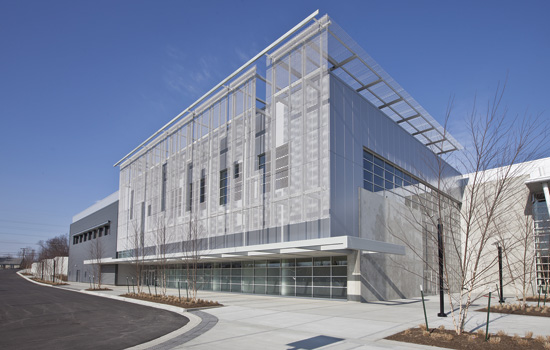 |
The Southland Christian Church benefits from the solar screening capabilities of aluminum expanded metal mesh to shield the façade and building interior from excess solar gains. Photo courtesy of AMICO |
Building Exterior Uses
Expanded metal is an ideal material for use on building exteriors. As a material used by any design architect, it can be used to turn even the most challenging of building types into a work of art. And since the metal is available in a range of durable and long lasting choices, it is able to withstand the rigor of exposure to weather, wind, and other environmental factors. Some of the more popular ways expanded metal mesh is used on building exteriors include the following:
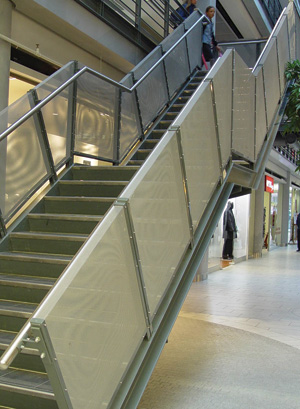 |
Expanded metal mesh is used on exterior and interior stairs as a full protection balustrade contributing to both safety and aesthetics. Photo courtesy of AMICO |
- Exterior Cladding: Expanded metal exterior cladding has become particularly popular over recent years and can be seen on many buildings such as The New Museum of Contemporary Art in New York City or The Young Vic Theatre in London. The designers of these buildings have discovered the ability of expanded metal mesh to act as both a visually appealing building façade material as well as an effective element of a wall assembly. Depending on the type and size of the openings, it can act as a very open and self-ventilating rainscreen over appropriate substrates. It can also provide protection to building elements that may be concealed below. In the process, it provides a wide range of choices for the finished appearance of the building that can change with changing conditions of natural and artificial light. Traditionally, expanded metal mesh has been used to act as a support substrate for plaster and stucco. Taking these uses one step further, manufacturers have developed the material to act in a supporting role on much larger projects. Expanded metal can be curved in both elevation and plan to create a shaped and sculptured structure or add strength and support to exterior cladding used on building facades.
- Solar Screening: In many commercial and institutional buildings, daylight is welcome as part of an indoor environment and as an alternative to electric lighting. However, the heat associated with sunlight is not always welcome nor is the glare and intensity of direct sunlight. Hence, architects have turned to numerous methods to deflect unwanted solar gains on building facades ranging from overhangs to glass treatments and others. Expanded metal mesh has been effectively providing this function as well when placed on the outside of a glazed building facade. Since the pattern of the openings and the depth of expanded metal mesh are all variable and customizable, it is possible to use it to create some very effective and innovative solar screening. For example, by arranging the size and shape of the diamonds in an expanded metal mesh it is possible to use the strands to deflect direct sunlight and cast shadows on glazing while using the apertures or openings to still provide views and allow diffuse or reflected daylight to enter the building. Further, the pattern can be adjusted as appropriate to address different orientations on different sides of the building such that the level of shading vs. daylighting can be optimized for each side.
- Ventilation: In certain cases daylight is not the design driver, rather, ventilation with a semblance of enclosure is needed. This would be the case in structures that don’t seek full enclosure such as parking garages or outdoor pavilions for example. Some security and protection are needed but so are ventilation and a sense of openness. Using expanded metal mesh can provide exactly that function on these structures by allowing air to flow freely through the openings in the mesh and even be directed by the angle of the mesh or the shape of the metal strands. And it can be installed in lieu of any other enclosure material without the need for any glazing. In effect it becomes a large scale screening that can meet all of the functional needs while providing an array of visual opportunities. The building can be enveloped in this material in a whole variety of artistic and creative designs causing an effect of greater articulation of design elements, more three dimensional appearances, and greater design impact overall.
- Exterior Balustrades: On exterior stairways, a means of filling in the balustrade area so that it is more fully enclosed for safety is often desirable while still wanting to create a visually appealing solution. Expanded metal mesh has been used in a number of different balustrade applications for commercial, industrial and institutional buildings with rather successful results. The variety of meshes, materials and finishes available make it quite possible to meet or exceed all code requirements for stairway and landing guard rails while still addressing the aesthetic design needs of a building.
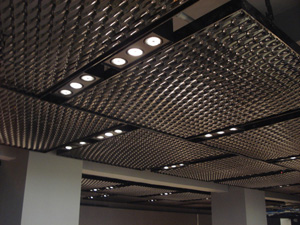 |
The ceiling of the DDC Minotti building uses large panels of very three-dimensional expanded metal mesh to create a strong interior design statement. Photo courtesy of AMICO |
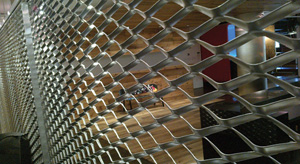 |
An interior partition made of expanded metal mesh will provide a physical separation while still allowing light and air to penetrate. Photo courtesy of AMICO |
Building Interior Uses
Moving to building interiors, expanded metal mesh has been similarly used in a variety of ways to define or complement an overall interior design scheme. Many building interiors require the durability and longevity of metal but also seek the open and airy attributes that expanded metal mesh can bring. Some of the more common applications include the following:
- Ceilings: Either large or small decorative metal panels can be fabricated from expanded metal mesh. The pattern, shape, depth, and materials can all be varied to create the best solution for a particular interior. The structure of expanded metal aids with the disruption of sound waves thus deadening noise and reducing echoes which can be further enhanced if needed with sound absorptive material behind the mesh. From a life safety point of view, the open area of the mesh allows sprinkler systems to be located above the mesh but still work effectively without being exposed to view. The open nature of the mesh means that air also readily flows through so HVAC grilles and diffusers can similarly be located above the mesh while still serving the spaces below. Lighting systems can be incorporated into a ceiling pattern or the ceiling can be used to distribute reflected light originating below it. The net effect is a ceiling system that is uniform and consistent in appearance without the unsightly disruptions of mechanical and electrical hardware or systems.
- Partitions: Interior decorative partitions are used for visual separation of spaces, for way-finding, and for the general definition of areas at all levels. In situations where some visual connection may be desired but a separation of spaces is needed for flow, security, or other reasons, then expanded metal mesh is an enticing solution. When used as an interior partition or screening, the mesh will still allow air flow and light to pass through such that mechanical and electrical systems need not be directly impacted by its presence. Depending on the metal used and the treatment, it can in fact be a true design feature. Expanded metal partitions and enclosures provide workers and equipment with protection, permit surveillance of critical plant areas, and act as barriers for in-plant traffic flow.
- Interior balustrades: Similar to exterior stairways, interior stairways can be treated with expanded metal mesh to fill in the balustrade area and provide safety for people using the stairs. The selection of the metal and the mesh design can blend with and enhance the rest of the interior treatments in the process.
Green Building Contributions
The USGBC LEED Green Building Rating System™ is recognized as the leading nationally accepted benchmark for the design, construction, and operation of a growing family of high performance green buildings. While LEED promotes a whole-building approach to sustainability, a significant supporting component can be found in the use of materials selected for any particular building. All LEED systems currently recognize performance in the seven key areas of sustainable sites, water efficiency, energy and atmosphere, materials and resources, indoor environmental quality, innovation in design and regional priority credits. Expanded metal mesh can contribute to credits in at least three of them; energy and atmosphere, materials and resources, and indoor environmental quality.
- Energy and Atmosphere — Optimize Energy Performance: Achieve increasing levels of energy performance above the baseline in the prerequisite standard to reduce environmental and economic impacts associated with excessive energy use. By using expanded metal mesh as sun shades or as an exterior facade, solar gain into the building is reduced, in turn reducing the amount of energy required to run HVAC systems.
- Indoor Environmental Quality — Provide for the building occupants a connection between indoor spaces and the outdoors through the introduction of daylight and views into the regularly occupied areas of the building (75%-90%). Expanded metal mesh products used in applications such as facades or sunshades can help maximize day lighting opportunities while decreasing artificial lighting as well as heating and cooling costs.
- Materials and Resources — There are several relevant points under this category:
- Construction Waste Management: Divert construction and demolition debris from disposal in landfills and incinerators. Since expanded metal mesh products are produced primarily from steel and other recyclable metals, any construction waste generated can and should be included in a construction waste management plan.
- Recycled Content: Increase demand for building products that incorporate recycled content materials, thereby reducing impacts resulting from extraction and processing of virgin materials. The majority of expanded metal mesh products are produced from North America’s most recycled materials such as steel and other metals with recycled content. Therefore, recycled content can easily be specified and achieved in construction.
- Regional Materials: Increase demand for building materials and products that have been extracted, harvested or recovered, as well as manufactured, within 500 miles of the project site. Many expanded metal mesh manufacturing facilities are located across North America and many purchase raw materials from vendors in close proximity to these locations. Regional material credits may well apply in many cases as a result.
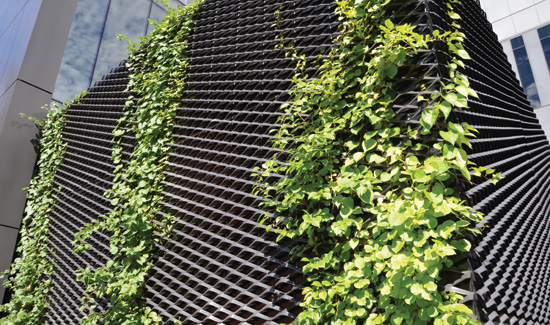 |
Expanded metal mesh can contribute to green building design criteria and allow for some environmentally innovative design approaches as well. Photo courtesy of AMICO |
Specifying Expanded Metal Mesh
Expanded metal mesh will likely be most appropriately specified based on its use in a building. So, following the CSI specification format, it may be specified under 05 70 00 Decorative Metal. However if it used for Building Cladding it would show up in 07 40 00 or for Exterior Sun Control Devices it may be specified in 10 71 13. Coordinating the most appropriate place to specify the mesh will obviously depend on the singular or multiple uses employed in any particular building.
The first step in the design of a product or fabricated assembly incorporating expanded metal is to select the appropriate expanded metal pattern, keeping in mind various product characteristics which may influence that choice. For example, the strength and rigidity of expanded metal is determined by Long Way of Diamond.
Diamond direction also affects air deflection and diffusion, concealment properties and aesthetic appearance. When determining which expanded metal products to use and specify, it is best to review the available options from manufacturers and assess the possibilities to select the most appropriate mesh that is consistent with the building use.
Once the basic parameters are determined, then within each individual specification section the following items will need to be addressed:
Scope and Quality Assurance
The scope of the expanded metal mesh work within a particular specification section will need to be identified particularly if there are other products used for the same purpose in the building. As described earlier, the NAAMM standard EMMA 557-12 “Standards for Expanded Metal” should be referenced as the industry standard for expanded metal mesh. Note that while the manufacture of expanded metal mesh is fairly precise, the standard identifies the normal and acceptable tolerances for flatness, camber, weight, and squareness. For example, the manufacturing tolerance of regular and flattened expanded metal is indicated in the standard as:
- SWD (short way of diamond) -Shall not vary greater than -0” +1/4 in. per foot of width (Example: 48” could be 49”)
- LWD (long way of diamond) -Shall not vary greater than -0” +1/4 in. per foot of length (Example: 96” could be 98”)
- Note: Generally all stock or machine run sheets will have closed diamonds on all four sides. Beyond that, the common standards for base metal such as ASTM standards or similar will apply.
 |
Expanded metal mesh is available in a full range of standard and specialty metals as may be appropriate to a particular architectural design. Image courtesy of AMICO |
Material and Product Type Selections
The variables in the expanded product include the following, each of which will need to be specified or identified:
Metal Type and Thickness: Starting with the specific metal type, those commonly used in the manufacture of expanded metal can include but are not necessarily limited to the following list with the corresponding ASTM references noted. The desired choice should be selected and identified and the thickness of the base metal determined for the application:
- Steel
- Cold-rolled (ASTM A 366/A 366M, A 611).
- Hot-rolled, and hot rolled - pickled and oiled (ASTM A1008 / A1008M, A1011 / A1011M).
- Galvanized before expanding (ASTM A 653/A 653M), or Electrogalvanized (ASTM A 879).
- Hot Dip Galvanized (ASTM A123/ A123M)
- Pre-finished-painted or plated.
- Aluminum
- Most common alloys 3003-H14, 5005-H34 and 5052-H32 (ASTM B 209).
- Pre-painted.
- Anodized.
- Stainless Steel
- Types 304 and 316 (including extra low-carbon grades) (ASTM A 666).
- Most 400 types ASTM A 176)
- 309 and 310 (ASTM A 167).
- Other Metals
- Copper, nickel alloys, CP titanium (grades 1 and 2), precious metals.
Expanded pattern: As described, the common pattern is based on a series of diamonds that emerge in the expanding process. It would be best to become familiar with the range of manufactured patterns first and then either specify a particular pattern or create a custom one based on the variable criteria of that pattern. These would include: strand width, unit weight, LWD and SWD dimensions, the final thickness of the expanded product (standard or flattened), the opening dimensions, and the free opening percentage for light or air to pass through. The expanding process yields a product whose overall thickness may be 1.5 to 5 times thicker than the base metal. If the material is flattened, it may be reduced continuously in thickness to 80 percent or less of the original material thickness. Foil material may have the overall thickness increased up to two times the strand width. Strand width can be varied somewhat to change the percentage of open area, thus meeting strength or aesthetic requirements.
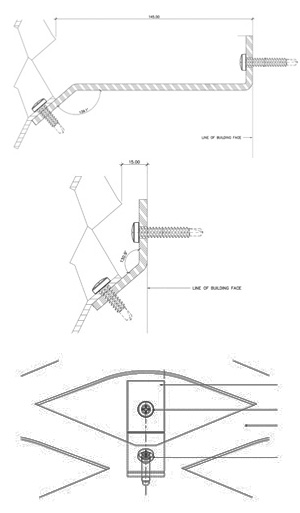 |
Elevation and section views of typical fastening clip details for the installation of expanded metal mesh in architectural applications. Photo courtesy of AMICO |
Piece or coil size: Once the pattern and style designation has been determined, the next consideration is the sheet size. When the quantity is relatively small and when there are no special qualifications regarding the edge configuration, it is nearly always best—in terms of both cost and lead-time—to select one of the many sheet sizes offered as “standard” by the manufacturer. However, most manufacturers can and do routinely furnish expanded metal in special (non-standard) sheet sizes when requested and when the quantity justifies. In this event, it is important for the specifier to give some consideration to the edge configuration of the sheet as it relates to any particular requirement since the cost may be affected by the manufacturing operations necessary to shear the edge desired. The significance of the edge condition is that when expanded metal mesh is cut or sheared, it may randomly cross through the solid and open parts of the mesh. If a particular edge condition is needed because it will be exposed, then that needs to be coordinated with the size of the sheet and the dimensions of the pattern. The designer’s decision regarding the edge conditions and tolerances is an important one. A consultation with a manufacturer, before a particular design is finalized, is recommended. This will assist in evaluation and comparison of the various alternatives and can provide specific manufacturing and cost information.
In general, because of the additional operations involved, sheared-tosize expanded metal will cost more than stock size sheets or machine run closed diamonds. Shearing allows for tighter tolerances, but will create open diamonds on any edge that is being sheared. Special size sheets can be furnished provided the sheet dimensions represent even multiples of the dimensions (both LWD and SWD) of the diamond pattern specified and provided that normal manufacturing tolerances will be acceptable. Stock-size sheets of most catalogued expanded metal products are generally available in quantity from steel distributors or from manufacturers. Practically any special design, size or shape can be produced to customer specification. Some patterns are available in coil as well as flat sheets. Custom manufactured sheet sizes or pieces, or material in coil form, are generally available on special order.
Coatings and Finishes: Because of its adaptability to metal finishing processes, expanded metal can be galvanized, anodized, coated, painted or plated for a variety of applications. Because of the light lubricant used during the expanding process, the product should be cleaned prior to finishing. Some of the lubricant used in manufacture is usually present on unfinished expanded metal surfaces and aids in the prevention of corrosion. When requested to furnish the product dry, the supplier shall not be responsible for conditions resulting from the absence of lubricants. In hot-dip galvanizing, there can be some warpage of metal because of high temperatures. In addition, galvanizing does not always produce a smooth and even coating. It is recommended that patterns of 1/2-in. (12.7mm), lighter than 0.084 in. (2mm), and large diamond patterns with a light weight per square foot not be galvanized. Consideration should be given to producing these items from pre-galvanized sheet metal.
Shipping and Installation
Expanded metal mesh will typically be shipped from the manufacturer ready to be fabricated or installed. If any overage or spare material is needed, it should be specified accordingly. The mesh will be shipped in either the coil or panel size specified to be used for final installation.
The mesh can be installed into frames or directly to the building using attachment methods designed and specified. Most manufacturers have a line of mesh fastening clips that are engineered to make the installation of expanded meshes secure and simple, without interfering with the aesthetics of the mesh.
Most basic of fastening clip designs allow for varying separations from the supporting structure by being fabricated in different sizes and shapes. When a basic clip design doesn’t match the needs of a project, then a manufacturing engineer or technical support team may be able to assist in the design and development of custom fastening solutions. The basic intent of the fastening should be called out on the drawings and specifications but shop drawings and installation drawings should be required as a submittal to assure conformance with the overall design requirements.
The final point to address in the specifications is the cleaning of the installed products to be sure that they are ready to function and look as good as possible. The specifications should call for normal cleaning and maintenance based on the nature of the metal and the location within or outside of the building.
Conclusion
Expanded metal mesh is enjoying a surge in use due to the accumulated expertise and understanding from over 100 years of expanded metal production techniques, capabilities and applications. Manufacturers are constantly pushing boundaries and developing new patterns, products and applications to increase availability and raise the design applications of expanded metal in architectural projects. Their strengths include a skilled and knowledgeable workforce coupled with sophisticated machinery, providing reliable engineering and technical support. Key benefits of working with expanded metal mesh include the versatility and availability of a wide range of materials and patterns in standard specifications, combined with a plethora of custom and innovative product possibilities. The diverse range of products that have already been used for decades in industrial and other building settings help to ensure that they will be appropriate and reliable for current and future projects as well.
Resources
For additional information, refer to the EMMA Division of NAAMM including a listing of the numerous ways that expanded metal mesh can be used in the built environment. http://www.naamm.org/emma/emma_product_uses.aspx
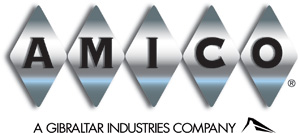 |
Alabama Metal Industries Corporation (AMICO) is an international manufacturer of expanded metal products, industrial grating/flooring, perforated metals, and building products. An extensive line of plastering, stucco and drywall building products, concrete forming products, security barrier products, and fi berglass structural products amplify AMICO’s entire product repertoire. www.amicoarch.com |

